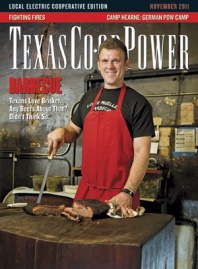On the Wing
GREAT cover photo [“On the Wing,” September 2011]. Great article, too! Question to photographer Wyatt McSpadden: How the heck did you get that neat photo? Loved it, loved it. Thanks for your eye-popping work.
Alan Gee, Central Texas Electric Cooperative
Editor’s note: To learn how McSpadden captured the stunning cover photo of agricultural aviation pilot Brett Whitten, read “WOOM! Whitten’s Picture-Perfect Day of Flying.”
Ag Aviation Pilots
My husband, Kenneth, and I were elated to read your article on ag pilots! Especially with all the photographs of Brett Whitten, who has been very involved with the Texas Agricultural Aviation Association, including as past president. Kenneth has sold one plane this year and bought two. He has flown all of North Texas with his crew of five pilots and most of Nebraska and Iowa this summer with his company there. Our son Brad is a military pilot who has just returned from Afghanistan. The country isn’t short of ag pilots—it is short of experienced ag pilots. When a fire starts here, the sheriff’s office calls Kenneth first. These new planes are astounding. As long as there are crops, these guys will be busy! Thank you for a wonderful article!
Emily Lauderdale, Lauderdale Spraying Service, Caldwell, Bluebonnet Electric Cooperative
I read the ag pilot story: I was touched by his story of being a hard worker and getting by.
Liz Morgenroth, Victoria Electric Cooperative
As much as I enjoy your articles each month, I was shocked to see “On the Wing” depicted on the cover as a cool, worthwhile and helpful profession. Seeing massive amounts of chemicals sprayed on our food, our Earth is nothing but sad. Our children deserve a better future than food laden with pesticides, which seep into groundwater and, more importantly, into the food we eat. A truly cool article would feature farmers working with the Earth—rather than against it—using organic methods to grow food.
Sharon Brown, Pedernales Electric Cooperative
It was a deep disservice to future Texans to highlight the plane(s) spraying God knows what on crops we’ll eat or wear. A very small amount of research will show conclusively that natural methods such as native plants, birds and bats effectively control all but the most rampant of infestations. In addition, the natural methods are a whole lot less expensive and don’t poison the Texas soil or squander our resources. Please be more sensitive to the Texas we’ll leave to our children.
Owen Yost, Landscape architect emeritus, CoServ Electric
Andrew D. Moore, executive director of the National Agricultural Aviation Association, provided a written response to criticisms of aerial crop application: “Regardless of whether a conventional or organic agricultural method is being used to raise a crop, materials to eradicate crop pests—such as weeds, fungi or insects—will very likely be applied. Organic agriculture uses pesticides that include copper sulfate and other effective insect-killing chemical compounds. Both organic and conventional farmers will use aerial application to treat crop pests when other forms of application, such as ground rigs, might result in crop damage. Modern or conventional agricultural production includes the judicious use of Environmental Protection Agency-approved pesticides and maximizes crop yields—food, fiber and biofuel—on fewer acres. The environmental benefits include providing more land for wildlife and preserving vegetative ecosystems important to the sequestration of carbon.”
Giddy-up
I was delighted with the “Ride of Passage” article in the September 2011 edition. Not only have I loved riding merry-go-rounds and carousels since I was a child, but I have a mustang named Carousel. He has lived with us for nearly 15 years now. He is creamy white with a pale-gold mane and tail and has blue eyes. He started out as my daughter’s horse, then stayed on with us when she married and left home. We named him Carousel because he looks like a little girl’s dream of the perfect merry-go-round pony. If he had a horn twisting out from under his forelock, he would look like a unicorn come to life! So, I was tickled that so many of the carousel ponies y’all showed in the article photos resembled our own Carousel pony … who, by the way, has a black corral pal named Cheyenne. She would be hurt if I neglected to mention her. Or at least my other daughter would be. Cheyenne, who was her horse, has also been with us for nearly 15 years.
Suzann Darnall, Pedernales Electric Cooperative
I loved your article on wooden carousels. While in San Diego, I had to ride the one located in Seaport Village and noted that it was originally in Fair Park in Dallas. It was built in the 1890s. I am wondering if this one in California was replaced by the current carousel that has been at Fair Park since 1971, or have there been other carousels in Dallas besides these two? Thanks for the great article that brought back fond memories of all the carousel rides I took as a child—and continue to take.
Marleen Greif, Mid-South Synergy
Patrick Wentzel, census chairman of the National Carousel Association responds: “The early history of the Seaport Village Charles Looff carousel is sketchy at best. We believe there were other carousels at State Fair Park before the current one made by William Dentzel was installed. The 1971 installation date for the State Fair Park Dentzel is our best determination at this time. Some sources believe the Dentzel was installed much earlier.”
I enjoyed the article “Ride of Passage.” It made me wonder what happened to the carousel that was operating at Forest Park in Fort Worth until the 1980s. I rode that and all the rides in the park as a little child in the early 1950s, and so did my son shortly before the rides were removed in the 1980s. I have fond memories of riding the carousel, as well as all the rides at Forest Park, and have pictures of me on one of the horses with my dad standing next to me. I also have enjoyed riding the carousel at Six Flags Over Texas, the first being in the 1960s, as well as at the Texas State Fair on several occasions and the fair in Lubbock in the 1950s. Thanks for the memories
Rita Isbell, Lighthouse Electric Cooperative
Wentzel again replies: “The Forest Park Carousel was a mixture of Charles Looff, Carmel and Parker animals. The carousel was broken up about 1988. I had the opportunity to photograph the carousel in 1986.”
Pinned Up to Dry
Re: “Letting It All Hang Out,” September 2011 letters. Sun-dried sheets are the best, but a close second is a spring-loaded, retractable clothesline inside the garage. My late wife and I started using one 20 years ago, and I’m still doing it, rain or shine. I only use a dryer for underwear and small items about every three weeks. Plus, I’m convinced my clothes last longer because they are not frequently pounded in the dryer.
Tom Sandlin, Pedernales Electric Cooperative
Sara Smith [“Letting It All Hang Out”] laments in her letter that deed restrictions in some communities prevent homeowners from using an outdoor clothesline. I found a company in Pennsylvania that sells several quality products for outdoor drying that comply with such restrictions. The website is www.breezedryer.com. I, too, am a fan of “solar” drying. Not only is it better for the environment and the electric bill, it’s better for the clothes. I bought a Hills Rotary Clothesline, and I couldn’t be happier! It is a very well-made product from Australia. It seems that nearly everyone hangs laundry outside in Australia, and they are baffled that more Americans don’t!
Suzanne Davis, Taylor Electric Cooperative
Freddie Steinmark
In your August 2011 edition, I read Jim Dent’s article about Freddie Steinmark [“Courage Beyond the Game”] and his connection to the University of Texas. What a terrible shame his sacrifice to win a national football championship. Early detection of cancer might have saved this fine boy.
Joe G. Cox, Pedernales Electric Cooperative
True Texas Colors
We’re no longer electric cooperative members, but a friend in Lubbock gave us the March 2011 issue to take home after a visit. After reading “Flag ’Em Down,” about photographer E. Joe Deering, we were inspired to show our true Texas colors by painting an antique window with the Texas flag and hanging it above the garage on our Michigan cabin near Big Rapids. For years, we were co-op members: first at Ransom Canyon, with South Plains Electric Cooperative, and later near Lago Vista, with Pedernales Electric Cooperative. Thanks to your publication, we found another way to show our loyalty to home.
Tom and Judy Vance, Spring
Loved Gluten-free Story
Re: “Meeting the Gluten-Free Challenge,” July, 2011 issue: Thank you, Kevin Hargis! Loved the gluten-free article and recipes!
Ann Lyons, Fayette Electric Cooperative


